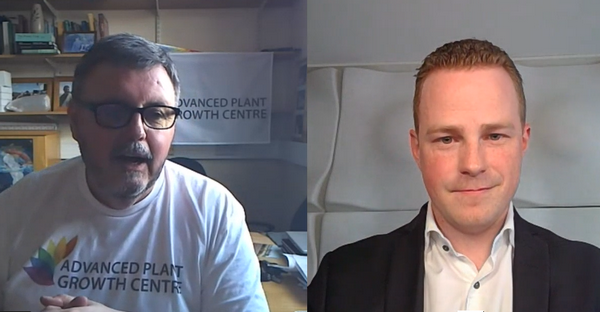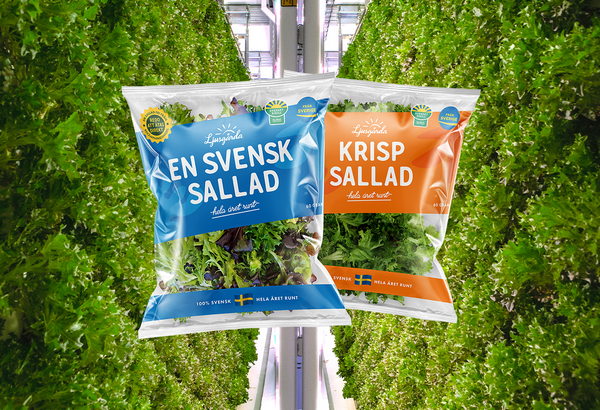"Many of us started or are starting in a small cellar or garage when figuring out vertical farming. Then, your operations are scaling up bit by bit," says Andreas Wilhelmsson, CEO of Ljusgårda, a Swedish vertical farm.
During a panel at the CEA 4.0, focusing on scaling up as a vertical farm, Andreas went through common issues growers mostly experience when starting a farm, and then scale. When starting, the first step for Ljusgarda was to quickly scale and move into a 7000m2 vacant building. Their farm expansion is set for another 18.000m2 that will be added to the total production area of the company.

Andreas during the panel
What to look out for when expanding
Important assets for when picking a location for a new farm are the following: Distribution, where can you have distribution centers located for grocery stores? As well as electricity and infrastructure, which is needed to grow and move around production.
Then, there are people. What kind of people are working in the region with the competence for what you do? "It’s hard to find people with experience in vertical farming, but you can find others like industrial- and IT knowledge, and so on. We’ll build inside in the region in Sweden, but not send it to Norway although we have the same distance from Oslo, as to Stockholm. Swedes want to buy local salads, so when we’re going into Norway, we’ll build a Norwegian factory and so."
Challenges
He continues, "When scaling up you will face totally different problems as to when exploring the growing side of things. The first one is in-house competence. In-house knowledge is needed in order to operate your farms, not only for growers but also for the team. You have to make sure that there are employees that know how to run a factory keeping it lean and high-quality. Many farmers are relying on external parties, but you need to strengthen your in-house knowledge to remedy certain issues."
Secondly, it's important to be prepared for automation, yet, starting manual. According to Andreas, a certain level of automation is needed in order to become profitable. However, automating all farm processes at the same time will become too inefficient. "First, you’ll have to be able to run them manually in order to be able to step in with people to secure your delivery. Later, farmers would want to optimize the machine they’re building. If you don’t optimize in time, you will not be able to do so in the long run."
Thirdly, hygiene, which is key in a vertical farm. "When scaling, the odds turn against you. If you don’t have hygiene under control, issues will arise, but technology cannot maintain that alone itself." The core is to educate staff on basic food security principles to avoid mistakes in the long run.
Last but not least is maintenance. Think about backup when you're changing your watts or how to respond to downtime. Growers have to be prepared for these sudden incidents, making sure equipment is taken care of. When everything is under control, you can start selling your products.
 The hanging conveyor system that allows Ljusgårda to move around their growing walls to any room they want, supplied by OCS
The hanging conveyor system that allows Ljusgårda to move around their growing walls to any room they want, supplied by OCS
Branding and sales
That brings us to the next important topic. Andreas notes that many customers don't have the sustainability aspect in mind when buying a product, research has shown. It's mainly about taste for them, whereas, farmers mostly miss the mark.
"We're always so proud of how much better our products are, ESG focused, and so on. However, we should focus on flavor and taste instead, and luckily, we can stimulate that through the controls." Coming along with that is the shelf life that is appreciated, not only by consumers but by retailers or restaurants as well. It results in much less waste, offering a lot more value to all parties.
Besides that, the pricing is mostly overestimated on what can be charged for a product, Andreas elaborates. Unfortunately, consumers are very price sensitive. That's why farmers have to make sure the product is competitively priced. Shelf-life, it’s very important to the store-owner and restaurant owner as it results in less waste. As well for the customer, as it offers much more value to them.
 The company's salads
The company's salads
A strong company culture
When production and sales are rolling, a strong team needs to be created that is connected with strong company culture. Building a culture inside a fast-growing company is usually starting with 10-15 people. They have the ability to create a certain culture, based on their personalities. However, after, you cannot easily shape or control the culture, but magnify what’s already there.
"When you find out what makes your company culture special, keep it and maintain it. Like our mission: making plants and people grow. We spend as much time growing with people as we do growing plants," he adds.
Lastly, Andreas recommended the following books to enlighten yourself on scaling up a company. The first one is ‘Scaling up’ by Verne Harnish and the second is ‘The five dysfunctions of a team’ by Patrick Lencioni.
 For more information:
For more information:
CEA 4.0
Jonathan Martin, Director
[email protected]
www.tech40.net
 For more information:
For more information:
Andreas Wilhelmsson, CEO
[email protected]
Ljusgårda
www.ljusgarda.se
